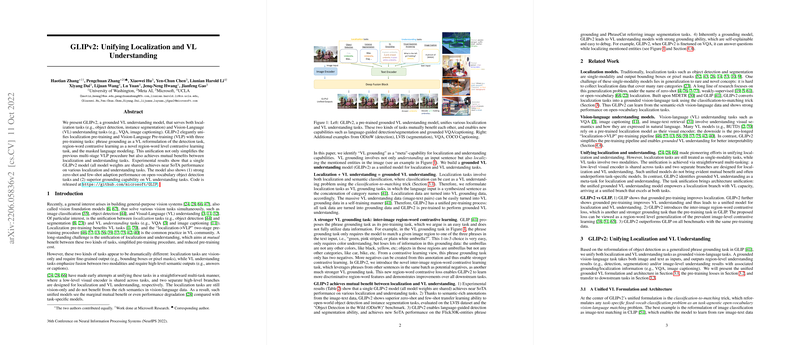Overview of GLIPv2: Unifying Localization and Vision-Language Understanding
The paper introduces GLIPv2, a unified model designed for both localization tasks (like object detection and instance segmentation) and Vision-Language (VL) understanding tasks such as Visual Question Answering (VQA) and image captioning. This work builds upon the growing interest in creating versatile vision systems that can handle a wide range of tasks using a single model architecture.
Model Architecture and Pre-training
GLIPv2 leverages a novel approach to unify these tasks through a shared architecture known as Architecture . This consists of a dual encoder for images and text, alongside a fusion encoder, allowing for comprehensive cross-modality feature extraction. The model employs a unified pre-training process that translates localization tasks into VL grounding tasks, utilizing synthesized sentences to represent category names and self-training on large-scale image-text pairs.
The pre-training is structured around three core tasks:
- Phrase Grounding: Reformulating detection tasks to enhance VL grounding.
- Region-Word Contrastive Learning: Introducing a batch-wise contrastive loss to improve feature discrimination.
- Masked LLMing: Incorporating semantic understanding from masked tokens.
Experimental Results
Empirical results demonstrate that GLIPv2 achieves near state-of-the-art (SoTA) performance across various benchmarks. Specifically, it excels in:
- Object Detection and Instance Segmentation: Showing robust zero-shot and few-shot capabilities.
- VL Understanding Tasks: Providing strong grounding capabilities beneficial for VQA and image captioning.
The paper highlights model efficiency with shared weights across different tasks, minimizing the need for task-specific tuning while maintaining competitive performance.
Implications and Future Directions
The unification of localization and VL understanding in GLIPv2 presents several practical and theoretical implications. Practically, it simplifies deployment in real-world applications where multi-task handling is crucial. Theoretically, it challenges the traditional separation of vision and language tasks, encouraging further research into integrated vision-LLMs.
Future work could explore scaling the model with additional weakly-supervised data, potentially improving the diversity of recognized concepts. The grounded VL understanding paradigm enables richer interpretability, fostering advancements in explainable AI.
Overall, GLIPv2 represents a promising step towards highly adaptive vision-language systems, setting a foundation for broader applications and more cohesive AI models.
